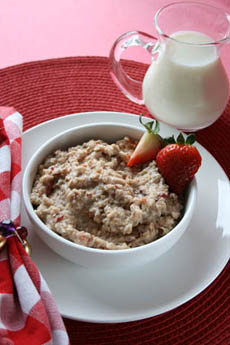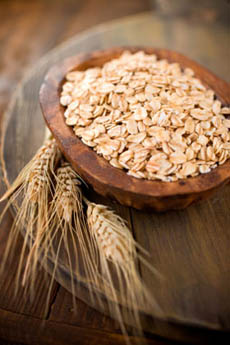HOLIDAY: National Oatmeal Day
|
It’s National Oatmeal Day.
The original oatmeal enthusiasts were the Scots, who were eating them many centuries ago when their English neighbors were only growing oats as livestock feed. The groats—the hulled kernels of the cereal—required soaking overnight and cooking for perhaps 30 minutes, so oatmeal was not exactly a convenience breakfast. But modern processing has made it very easy for us to enjoy oatmeal in a minute—and good oatmeal in five to ten minutes. ROLLED OATS Rolled oats are what most Americans think of as oatmeal. Quaker Oats’ Old Fashioned Oats have been breakfast fare for generations. To make rolled oats, the groats are flattened under giant rollers, which makes them easier to cook but removes much of the fiber-filled bran in the process. There are different types of rolled oats: |
The most familiar form of oats are rolled oats, where the groats are rolled flat. Photo by Kelly Cline | IST. |
|
|
The thinner that oats are rolled, the more surface area they have, the quicker they cook. However, the more oats are processed, the more nutritional value is lost. And, alas, texture and flavor is lost as well, creating a blander, mushier product—and the popularity of highly sugared and flavored instant oats. |
||
 Steel cut oats, the original oatmeal. Photo by Hannah Kaminsky | THE NIBBLE. |
STEEL-CUT OATS
Steel-cut oats, also called cut oats, Irish oats or Scottish oats, and coarse-cut oats, are groats (the whole oat kernel) that have been cut into very small pieces using steel discs. This produces a different result from rolled into flakes. They are a far better source of fiber than rolled oats, and delightfully chewy (note: baked goods should be made with rolled oats, unless you want a chewy oat bread or muffin). Cooking time is considerably longer than for rolled oats—30 minutes—but the cooked oatmeal has a nice texture to it—it’s more al dente than rolled oats (and our favorite). The luxurious texture and longer cooking time imparts more flavor as well. Oatmeal imported from Ireland and Scotland, like McCann’s and Flahavan’s, tends to be steel-cut oats. Our trick to speedier steel-cut oats: Make a double or triple batch; refrigerate the extra portions and microwave them for “one-minute steel-cut oats.” |
|
|
|
||



